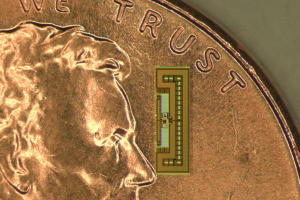Micro-miniature intelligent radio devices are poised to revolutionize the connectivity of objects in ways that could open doors to new diagnostic devices to help pathologists detect disease
In the future, both in vitro diagnostics and in vivo diagnostics will utilize ever-smaller devices. The shrinking size of these analytical devices will give pathologists and clinical laboratory scientists new tools to detect disease earlier, while monitoring patient with chronic conditions in real-time in consultation with attending physicians.
Now comes news of a significant breakthrough that will allow researchers to shrink down the size of devices used for a wide range of applications, including medical laboratory testing. Engineers from Stanford University and the University of California, Berkeley, have created a prototype radio-on-a-chip the size of an ant.
Their invention could enable a vast assortment of gadgets to connect and communicate with each other, and with physicians, via the Internet. The new device has the potential for numerous applications for pathology and medical laboratories, and could be used in many types of diagnostic testing devices, including in vivo diagnostics.

Amin Arbabian, Ph.D., Assistant Professor of Electrical Engineering at Stanford University, believes this technology is the “next wave of wireless devices,” what he describes as the “Internet of Things” or the “Internet of Everything.” (Photography copyright: Amin Arbabian/Stanford University)
The Internet of Things in Support of Medical Laboratory Testing
Much of the infrastructure needed to enable remote control of sensors and devices already exists, reported a Stanford News story. The Internet carries commands around the globe. Computers and smartphones issue the commands. What’s been missing is a wireless controller cheap enough to be installed on any gadget anywhere, creating an “Internet of Things.”
“The next exponential growth in connectivity will be connecting objects together and giving us remote control through the web,” declared team leader Amin Arbabian, Ph.D., Assistant Professor of Electrical Engineering at Stanford, in a Gizmag article. “We’re ultimately talking about connecting trillions of devices,” he observed.
Stanford Team Develops New Miniaturization Techniques
The miniscule Stanford radio works by combining wireless communication, inbuilt logic control, and remote sensing, according to Gizmag. It receives, processes and transmits data via antennas and a central processor. It can compute, execute, and relay commands.
Arbabian and his team had initially focused on making a radio small enough to put on bank notes or pills, noted a Stanford Daily story. They faced two major challenges:
1. How to effectively deliver power to the radio, and,
2. How to enable operations within a dense network.
Current radios have already been shrunk down to the size of a quarter, Gizmag reported. The Stanford engineers were faced with squeezing all the electronics of a radio into a tiny silicon chip. “In the past when people thought about miniaturizing radios, they thought about it in terms of shrinking the size of the components,” noted Arbabian in the Stanford News story.
But Arbabian’s team took a dramatically different approach. To reduce both size and cost, they developed new techniques for miniaturizing devices on silicon chips. Essentially, they re-engineered every function in the radio, according to a GNC technology blog post. Imagine an ant measuring about 3.7 x 1.2 millimeters crawling across a quarter. That’s the miniaturization feat Arbabian’s team achieved.

Researchers have created a prototype ant-sized device powered by ambient radio waves. The tiny radio-on-a-chip gathers all the power it needs from the same electromagnetic waves that carry signals to its receiving antenna. (Photography/caption copyright: Amin Arbabian/Stanford University)
New Low-power Radio-on-a-Chip Less Costly to Manufacture and Operate
The Stanford radio has two differentiating features:
1. It’s cheap to make. This is critical to enabling the mass connectivity of objects.
2. It doesn’t require batteries to run. It’s extremely energy efficient. The receiving antenna—one-tenth the size of a Wi-Fi antenna—scavenges energy from incoming electromagnetic waves. The same electromagnetic waves that carry signals to its receiving antenna also supply all the power it needs.
“[These ant-sized radios] have electromagnetic waves to not only deliver the message but also deliver the power,” declared Arbabian in the Stanford Daily story. Using ambient power means lower cost to operate the radio. “Our chip is consuming an average of 1.5 microwatts of standby power,” added Arbabian in the GNC piece. “If you compare that to the wireless standards today, it is orders of magnitude lower.” The engineers were able to achieve this feat by developing a chip that uses a much higher frequency millimeter wave than the conventional radio.
Future Cell Phones Will Connect to Arbabian’s Miniature Radios
Currently, Stanford’s radio performs only over short distances, Stanford Daily reported. To actually deploy the devices would require base stations that support the Stanford protocol. However, according to Arbabian, support for millimeter wave communications is growing rapidly. “Already, some in the mobile industry are integrating millimeter wave receivers on mobile devices,” he stated. “So we can leverage the fact that cell phones in the near future will have millimeter wave capability and can act as a gateway to these radios.”
Clinical Diagnostics and Patient Monitoring: Potential Uses for Radio-on-a-Chip
Arbabian foresees numerous potential applications for the new radio, according to GNC. For one, he said that tiny sensors could be affixed to a band issued to hospital inpatients. The device could continuously transmit body temperature to a computer that continuously monitors readings for signs of infection. Another application would be to affix the chip radio to instruments used during surgery. This could ensure that no instruments get left inside the patient. “You can put one of these radios on every single item in the operating room,” declared Arbabian.
Pathologists and medical laboratory scientists have good reason to monitor the development of radio-on-a-chip technology—even for non-medical purposes. The Internet of Things may enable virtually universal interconnectedness among people, devices, and wireless data. This makes it not only useful for exchanging information in clinical laboratory environments, but also for converting traditional in vivo laboratory tests into monitoring technologies that could deliver results remotely, bypassing traditional laboratory workflows.
–Pamela Scherer McLeod
Related Information:
Stanford Team Invents Sensor That Uses Radio Waves to Detect Subtle Changes in Pressure
Stanford Engineers Aim to Connect the World with Ant-sized Radios
Ant-sized Radios Could Help Connect Trillions of Devices to the Internet of Things
Engineers Made a Battery-Free Radio the size of an Ant
Stanford Researchers Develop Ant-Sized Radio



